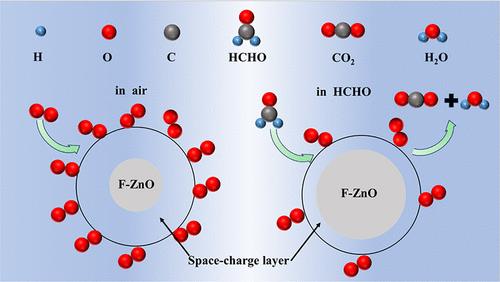基于紫外光激活的掺杂 F 氧化锌纳米结构的超灵敏室温甲醛传感器
IF 3.7
2区 化学
Q2 CHEMISTRY, MULTIDISCIPLINARY
引用次数: 0
摘要
开发一种可在室温下工作且检测限低的超灵敏甲醛(HCHO)传感器迫在眉睫。金属氧化物半导体是极佳的气敏材料。因此,本文通过优化氟掺杂水平,采用简单的一锅法合成了氟(F)掺杂氧化锌(ZnO)多孔纳米材料,实现了室温紫外光下低浓度 HCHO 的检测。在 375 nm 紫外光下,该传感器对 10 ppm HCHO 的响应值为 386%,是纯 ZnO 的 2.6 倍,检测限低至 75 ppb。它具有优异的选择性、稳定性和防潮性,可以满足日常生活中对 HCHO 的检测要求。分析表明,在氧化锌中掺入 F 不仅能增加材料的比表面积,还能引入活性位点。此外,它还改变了材料表面的 HCHO 状态,从物理吸附变为化学吸附。上述原因共同增强了气敏材料对 HCHO 的吸附,从而提高了其气敏性能。总之,这项工作证明了掺杂 F 的氧化锌是一种潜在的超灵敏 HCHO 传感器材料,并为解释掺杂对材料气敏性能的影响提供了启示。本文章由计算机程序翻译,如有差异,请以英文原文为准。

Ultrasensitive Room Temperature Formaldehyde Sensors Based on F Doped ZnO Nanostructures Activated by UV Light
It is urgent to develop an ultrasensitive formaldehyde (HCHO) sensor that can operate at room temperature and has a low detection limit. Metal oxide semiconductors are excellent gas sensitive materials. Therefore, in this paper, we present the synthesis of fluorine (F) doped zinc oxide (ZnO) porous nanomaterials through a straightforward one-pot method with the optimization of F doping levels to achieve the detection of low concentrations of HCHO under UV light at room temperature. Under 375 nm UV light, the sensor exhibits a response value of 386% to 10 ppm of HCHO, which is 2.6 times higher than that of pure ZnO, and its detection limit is as low as 75 ppb. It has excellent selectivity, stability, and moisture resistance, which can meet the requirements of HCHO detection in daily life. Analysis reveals that doping ZnO with F not only increases the material’s specific surface area but also introduces active sites. Furthermore, it alters the state of HCHO on the material’s surface from physical adsorption to chemical adsorption. The above reasons together enhance the adsorption of HCHO on the gas sensitive material, thereby improving its gas sensitivity performance. Overall, this work demonstrates that F-doped ZnO is a potential material for ultrasensitive HCHO sensors and provides insights into the interpretation of the effect of doping on the gas sensitivity properties of materials.
求助全文
通过发布文献求助,成功后即可免费获取论文全文。
去求助
来源期刊

Langmuir
化学-材料科学:综合
CiteScore
6.50
自引率
10.30%
发文量
1464
审稿时长
2.1 months
期刊介绍:
Langmuir is an interdisciplinary journal publishing articles in the following subject categories:
Colloids: surfactants and self-assembly, dispersions, emulsions, foams
Interfaces: adsorption, reactions, films, forces
Biological Interfaces: biocolloids, biomolecular and biomimetic materials
Materials: nano- and mesostructured materials, polymers, gels, liquid crystals
Electrochemistry: interfacial charge transfer, charge transport, electrocatalysis, electrokinetic phenomena, bioelectrochemistry
Devices and Applications: sensors, fluidics, patterning, catalysis, photonic crystals
However, when high-impact, original work is submitted that does not fit within the above categories, decisions to accept or decline such papers will be based on one criteria: What Would Irving Do?
Langmuir ranks #2 in citations out of 136 journals in the category of Physical Chemistry with 113,157 total citations. The journal received an Impact Factor of 4.384*.
This journal is also indexed in the categories of Materials Science (ranked #1) and Multidisciplinary Chemistry (ranked #5).
 求助内容:
求助内容: 应助结果提醒方式:
应助结果提醒方式:


